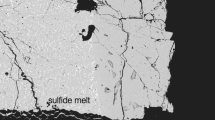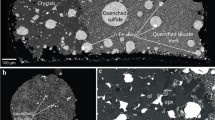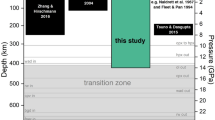Abstract
The behavior of nickel in the Earth’s mantle is controlled by sulfide melt–olivine reaction. Prior to this study, experiments were carried out at low pressures with narrow range of Ni/Fe in sulfide melt. As the mantle becomes more reduced with depth, experiments at comparable conditions provide an assessment of the effect of pressure at low-oxygen fugacity conditions. In this study, we constrain the Fe–Ni composition of molten sulfide in the Earth’s upper mantle via sulfide melt–olivine reaction experiments at 2 GPa, 1200 and 1400 °C, with sulfide melt \(X_{{{\text{Ni}}}}^{{{\text{Sulfide}}}}=\frac{{{\text{Ni}}}}{{{\text{Ni}}+{\text{Fe}}}}\) (atomic ratio) ranging from 0 to 0.94. To verify the approach to equilibrium and to explore the effect of \({f_{{{\text{O}}_{\text{2}}}}}\) on Fe–Ni exchange between phases, four different suites of experiments were conducted, varying in their experimental geometry and initial composition. Effects of Ni secondary fluorescence on olivine analyses were corrected using the PENELOPE algorithm (Baró et al., Nucl Instrum Methods Phys Res B 100:31–46, 1995), “zero time” experiments, and measurements before and after dissolution of surrounding sulfides. Oxygen fugacities in the experiments, estimated from the measured O contents of sulfide melts and from the compositions of coexisting olivines, were 3.0 ± 1.0 log units more reduced than the fayalite–magnetite-quartz (FMQ) buffer (suite 1, 2 and 3), and FMQ − 1 or more oxidized (suite 4). For the reduced (suites 1–3) experiments, Fe–Ni distribution coefficients \(K_{{\text{D}}}^{{}}=\frac{{(X_{{{\text{Ni}}}}^{{{\text{sulfide}}}}/X_{{{\text{Fe}}}}^{{{\text{sulfide}}}})}}{{(X_{{{\text{Ni}}}}^{{{\text{olivine}}}}/X_{{{\text{Fe}}}}^{{{\text{olivine}}}})}}\) are small, averaging 10.0 ± 5.7, with little variation as a function of total Ni content. More oxidized experiments (suite 4) give larger values of KD (21.1–25.2). Compared to previous determinations at 100 kPa, values of KD from this study are chiefly lower, in large part owing to the more reduced conditions of the experiments. The observed difference does not seem attributable to differences in temperature and pressure between experimental studies. It may be related in part to the effects of metal/sulfur ratio in sulfide melt. Application of these results to the composition of molten sulfide in peridotite indicates that compositions are intermediate in composition (\(X_{{{\text{Ni}}}}^{{{\text{sulfide}}}}\) ~ 0.4–0.6) in the shallow mantle at 50 km, becomes more Ni rich with depth as the O content of the melt diminishes, reaching a maximum (0.6–0.7) at depths near 80–120 km, and then becomes more Fe rich in the deeper mantle where conditions are more reduced, approaching (\(X_{{{\text{Ni}}}}^{{{\text{sulfide}}}}\) ~ 0.28) > 140 km depth. Because Ni-rich sulfide in the shallow upper mantle melts at lower temperature than more Fe-rich compositions, mantle sulfide is likely molten in much of the deep continental lithosphere, including regions of diamond formation.










Similar content being viewed by others
References
Alard O, Griffin WL, Lorand JP, Jackson SE, O’Reilly SY (2000) Non-chondritic distribution of the highly siderophile elements in mantle sulfides. Nature 407:891–894
Ariskin AA, Danyushevsky LV, Bychkov KA, McNeill AW, Barmina GS, Nikolaev GS (2013) Modeling solubility of Fe-Ni sulfides in basaltic magmas: the effect of nickel. Econ Geol 108:1983–2003
Aulbach S, Griffin WL, Pearson NJ, O’Reilly SY, Kivi K, Doyle BJ (2004) Mantle formation and evolution, Slave Craton: constraints from HSE abundances and Re–Os isotope systematics of sulfide inclusions in mantle xenocrysts. Chem Geol 208:61–88
Aulbach S, Creaser R, Pearson NJ, Simonetti SS, Heaman LM, Griffin WL, Stachel T (2009) Sulfide and whole rock Re–Os systematics of eclogite and pyroxenite xenoliths from the Slave Craton, Canada. Earth Planet Sci Lett 283:48–58
Ballhaus C, Bockrath C, Wohlgemuth-Ueberwasser C, Laurenz V, Berndt J (2006) Fractionation of the noble metals by physical processes. Contrib Mineral Petrol 152:667–684
Barkman JE, Carpenter P, Zhao JC, Donovan J (2013) Electron microprobe quantitative mapping vs. defocused beam analysis. Microsc Microanal 19(Supplement S2):848–849
Barnes SJ, Godel B, Gürer D, Brenan JM, Robertson J, Paterson D (2013) Sulfide–olivine Fe–Ni exchange and the origin of anomalously Ni rich magmatic sulfides. Econ Geol 108:1971–1982
Baró J, Sempau J, Fernández-Varea JM, Salvat F (1995) PENELOPE: an algorithm for Monte Carlo simulation of the penetration and energy loss of electrons and positrons in matter. Nucl Instrum Methods Phys Res B 100:31–46
Berman (1988) Internally-consistent thermodynamic data for minerals in the system Na2O–K2O–CaO–MgO–FeO–Fe2O3–Al2O3–SiO2–TiO2–H2O–CO2. J Petrol 29:445–522
Bockrath C, Ballhaus C, Holzheid A (2004) Fractionation of the platinum group elements during mantle melting. Science 305:1951–1954
Boehler R (1992) Melting of the Fe-FeO and the Fe-FeS systems at high pressure: constraints on core temperatures. Earth Planet Sci Lett 111:217–227
Brenan JM (2003) Effects of ƒO2, fS2, temperature, and melt composition on Fe–Ni exchange between olivine and sulfide liquid: implications for natural olivine–sulfide assemblages. Geochim Cosmochim Acta 67:2663–2681
Brenan JM (2015) Se–Te fractionation by sulfide–silicate melt partitioning: Implications for the composition of mantle-derived magmas and their melting residues. Earth Planet Sci Lett 422:45–57
Brenan JM, Caciagli NC (2000) Fe–Ni exchange between olivine and sulphide liquid: Implications for oxygen barometry in sulphide-saturated magmas. Geochim Cosmochim Acta 64:307–320
Bruhn D, Groebner N, Kohlstedt DL (2000) An interconnected network of core-forming melts produced by shear deformation. Nature 403:883–886
Carpenter PK, Zeigler RA, Jolliff BL (2010) Advances in defocused-beam analysis and compositional mapping with the electron probe microanalyzer. Microsc Microanal 16:894–895
Clark T, Naldrett AJ (1972) The distribution of Fe and Ni between synthetic olivine and sulfide at 900 degrees C. Econ Geol 67:939–952
Dasgupta R, Buono A, Whelan G, Walker D (2009) High-pressure melting relations in Fe–C–S systems: Implications for formation, evolution, and structure of metallic cores in planetary bodies. Geochim Cosmochim Acta 73:6678–6691
Delpech G, Lorand JP, Grégoirec M, Cottind JY, O’Reilly SY (2012) In-situ geochemistry of sulfides in highly metasomatized mantle xenoliths from Kerguelen, southern Indian Ocean. Lithos 154:296–314
Ding S, Dasgupta R (2017) The fate of sulfide during decompression melting of peridotite—implications for sulfur inventory of the MORB-source depleted upper mantle. Earth Planet Sci Lett 459:183–195
Dohmen R, Chakraborty S, Becker HW (2002) Si and O diffusion in olivine and implications for characterizing plastic flow in the mantle. Geophys Res Lett 29:2030
Dohmen R, Becker HW, Chakraborty S (2007) Fe–Mg diffusion in olivine I: experimental determination between 700 and 1200 °C as a function of composition, crystal orientation and oxygen fugacity. Phys Chem Miner 34:389–407
Doyle CD, Naldrett AJ (1987) The oxygen content of “sulfide” magma and its effect on the partitioning of nickel between coexisting olivine and molten ores. Econ Geol 82:208–211
Eggler D, Lorand JP (1993) Mantle sulfide geobarometry. Geochim Cosmochim Acta 57:2213–2222
Eugster H, Wones D (1962) Stability relations of the ferruginous biotite, annite. J Petrol 3:82–125
Fleet ME, MacRae ND (1983) Partition of Ni between olivine and sulfide and its application to Ni–Cu sulfide deposits. Contrib Mineral Petrol 83:75–81
Fleet ME, MacRae ND (1987) Partition of Ni between olivine and sulfide: the effect of temperature, ƒO2, and fS2. Contrib Mineral Petrol 95:336–342
Fleet ME, MacRae ND (1988) Partition of Ni between olivine and sulfide: equilibria with sulfide-oxide liquids. Contrib Mineral Petrol 100:462–469
Frost DJ, McCammon CA (2008) The redox state of earth’s mantle. Annu Rev Earth Planet Sci 36:389–420
Gaetani GA, Grove TL (1997) Partitioning of moderately siderophile elements among olivine, silicate melt, and sulfide melt: constraints on core formation in the Earth and Mars. Geochim Cosmochim Acta 61:1829–1846
Gaetani GA, Grove TL (1999) Wetting of mantle olivine by sulfide melt: implications for Re/Os ratios in mantle peridotite and late-stage core formation. Earth Planet Sci Lett 169:147–163
Griffin WL, Murthy VR (1969) Distribution of K, Rb, Sr and Ba in some minerals relevant to basalt genesis. Geochim Cosmochim Acta 33:1389–1414
Groebner N, Kohlstedt DL (2006) Deformation-induced metal melt networks in silicates: implications for core–mantle interactions in planetary bodies. Earth Planet Sci Lett 245:571–580
Hasterok D, Chapman DS (2011) Heat production and geotherms for the continental lithosphere. Earth Planet Sci Lett 307:59–70
Helffrich G, Kendall M, Hammond JOS, Carroll MR (2011) Sulfide melts and long-term low seismic wavespeeds in lithospheric and asthenospheric mantle. Geophys Res Lett 38:11301–11305
Hirschmann M (1991) Thermodynamics of multicomponent olivines and the solution properties of (Ni,Mg,Fe)2SiO4 and (Ca,Mg,Fe)2SiO4 olivines. Am Mineral 76:1232–1248
Hirth G, Kohlstedt DL (1995) Experimental constraints on the dynamics of the partially molten upper mantle: deformation in the diffusion creep regime. J Geophys Res 100:1981–2001
Holzapfel C, Chakraborty S, Rubie DC, Frost DJ (2007) Effect of pressure on Fe–Mg, Ni and Mn diffusion in (FexMg1−x)2SiO4 olivine. Phys Earth Planet Inter 162:186–198
Holzheid A, Grove TL (2002) Sulfur saturation limits in silicate melts and their implications for core formation scenarios for terrestrial planets. Am Mineral 87:227–237
Holzheid A, Grove TL (2005) The effect of metal composition on Fe–Ni partition behavior between olivine and FeNi-metal, FeNi-carbide, FeNi-sulfide at elevated pressure. Chem Geol 221:207–224
Holzheid A, Schmitz MD, Grove TL (2000) Textural equilibria of iron sulfide liquids in partly molten silicate aggregates and their relevance to core formation scenarios. J Geophys Res 105:13555–13567
Hsieh K-C, Schmid R, Chang YA (1987) The Fe–Ni–S system II. A thermodynamic model for the ternary monosulfide phase with the nickel arsenide structure. High Temp Sci 23:39–52
Jarosewich E, Nelen JA, Norbers JA (1980) Reference samples for electron microprobe. Geostand Geoanal Res 4:43–47
Jenner FE, O’Neill HSTC, Arculus RJ, Mavrogenes JA (2010) The magnetite crisis in the evolution of Arc-related magmas and the initial concentration of Au, Ag and Cu. J Petrol 51:2445–2464
Jones AG, Lezaet P, Ferguson IJ, Chave AD, Evans RL, Garcia X, Spratt J (2003) The electrical structure of the Slave craton. Lithos 71:505–527
Jugo PJ (2009) Sulfur content at sulfide saturation in oxidized magmas. Geology 37:415–418
Jugo PJ, Luth RW, Richards JP (2005) An experimental study of the sulfur content in basaltic melts saturated with immiscible sulfide or sulfate liquids at 1300 °C and 1.0 GPa. J Petrol 46:783–798
Kiseeva ES, Fonseca ROC, Smythe DJ (2017) Chalcophile elements and sulfides in the upper mantle. Elements 13:111–116
Kress V (1997) Thermochemistry of sulfide liquids. I. the system O–S–Fe at 1 bar. Contrib Mineral Petrol 127:176–186
Kress V (2000) Thermochemistry of sulfide liquids. II. Associated solution model for sulfide liquids in the system O–S–Fe. Contrib Mineral Petrol 139:316–325
Kress V (2007) Thermochemistry of sulfide liquids III: Ni-bearing liquids at 1 bar. Contrib Mineral Petrol 154:191–204
Kress V, Greene LE, Ortiz MD, Mioduszewski L (2008) Thermochemistry of sulfide liquids IV: density measurements and the thermodynamics of O–S–Fe–Ni–Cu liquids at low to moderate pressures. Contrib Mineral Petrol 156:785
Li C, Ripley EM (2005) Empirical equations to predict the sulfur content of mafic magmas at sulfide saturation and applications to magmatic sulfide deposits. Mineral Depos 40:218–230
Li Y, Dasgupta R, Tsuno K (2015) The effects of sulfur, silicon, water, and oxygen fugacity on carbon solubility and partitioning in Fe-rich alloy and silicate melt systems at 3 GPa and 1600 °C: implications for core–mantle differentiation and degassing of magma oceans and reduced planetary mantles. Earth Planet Sci Lett 415:54–66
Liu Y, Samaha NT, Baker DR (2007) Sulfur concentration at sulfide saturation (SCSS) in magmatic silicate melts. Geochim Cosmochim Acta 71:1783–1799
Llovet X, Galan G (2003) Correction of secondary X-ray fluorescence near grain boundaries in electron microprobe analysis: application to thermobarometry of spinel lherzolites. Am Mineral 88:121–130
Lorand JP, Luguet A, Alard O (2013) Platinum-group element systematics and petrogenetic processing of the continental upper mantle: a review. Lithos 164–167:2–21
Mavrogenes JA, O’Neill HS (1999) The relative effects of pressure, temperature and oxygen fugacity on the solubility of sulfide in mafic magmas. Geochim Cosmochim Acta 63:1173–1180
McDonald I, Hughes HSR, Butler IB, Harris JW, Muir D (2017) Homogenisation of sulphide inclusions within diamonds: a new approach to diamond inclusion geochemistry. Geochim Cosmochim Acta 216:335–357
McDonough WF, Sun SS (1995) The composition of the Earth. Chem Geol 120:223–253
McGuire AV, Francis CA, Dyar MD (1992) Mineral standards for electron microprobe analysis of oxygen. Am Mineral 77:1087–1091
Médard E, McCammon C, Barr JA, Grove T (2008) Oxygen fugacity, temperature reproducibility, and H2O contents of nominally anhydrous piston-cylinder experiments using graphite capsules. Am Mineral 93:1838–1844
Minarik WG, Ryerson FJ, Watson EB (1996) Textural entrapment of core-forming melts. Science 272:530–533
O’Neill HS (1991) The origin of the Moon and the early history of the Earth—a chemical model. Part 2: the Earth. Geochim Cosmochim Acta 55:1159–1172
O’Neill HS, Mavrogenes JA (2002) The sulfide capacity and the sulfur content at sulfide saturation of silicate melts at 1400 °C and 1 bar. J Petrol 43:1049–1087
Pearson DG, Wittig N (2014) The formation and evolution of cratonic mantle lithosphere: evidence from mantle xenoliths. In: Holland HD, Turekian KK (eds) Treatise on geochemistry, 2nd edn. Elsevier, Oxford, pp 255–292
Pearson DG, Canil D, Shirey SB (2003) Mantle samples included in volcanic rocks: xenoliths and diamonds. Treatise Geochem 2:171–275
Petry C, Chakraborty S, Palme H (2004) Experimental determination of Ni diffusion coefficients in olivine and their dependence on temperature, composition, oxygen fugacity, and crystallographic orientation. Geochim Cosmochim Acta 68:4179–4188
Raghavan V (2004) Fe–Ni–S (Iron–Nickel–Sulfur). J Phase Equilib Diffus 25:373–381
Rohrbach A, Ballhaus C, Gola-Schindler U, Ulmer P, Kamnetsky VS, Kuzmin DV (2007) Metal saturation in the upper mantle. Nature 449:456–460
Rohrbach A, Ballhaus C, Ulmer P, Kamnetsky VS, Gola-Schindler U (2011) Experimental evidence for a reduced metal-saturated upper mantle. J Petrol 52:717–731
Ryzhenko B, Kennedy GC (1973) The effect of pressure on the eutectic in the system Fe-FeS. Am J Sci 273:803–810
Sack RO, Ghiorso MS (1989) Importance of considerations of mixing properties in establishing an internally consistent thermodynamic database: thermochemistry of minerals in the system. Contrib Mineral Petrol 102:41–68
Shannon MC, Agee CB (1998) Percolation of core melts at lower mantle conditions. Science 280:1059–1061
Shi CY, Zhang L, Yang W, Liu Y, Wang J, Meng Y, Andrews JC, Mao WL (2013) Formation of an interconnected network of iron melt at Earth’s lower mantle conditions. Nat Geosci 6:971–975
Smith E, Shirey SB, Nestola F, Bullock E, Wang J, Richardson SH, Wang W (2016) Large gem diamonds from metallic liquid in Earth’s deep mantle. Science 354:1403–1405
Smythe DJ, Wood BJ, Kiseeva ES (2017) The S content of silicate melts at sulfide saturation: new experiments and a model incorporating the effects of sulfide composition. Am Mineral 102:795–803
Stanley B, Hirschmann M, Withers A (2014) Solubility of COH volatiles in graphite-saturated martian basalts. Geochim Cosmochim Acta 129:54–76
Tsuno K, Dasgupta R (2015) Fe–Ni–Cu–C–S phase relations at high pressures and temperatures—the role of sulfur in carbon storage and diamond stability at mid- to deep-upper mantle. Earth Planet Sci Lett 412:132–142
Urakawa S, Kato M, Kumazawa M (1987) Experimental study on the phase relations in the system Fe–Ni–O–S up to 15 GPa. In: Manghnani MH, Syono Y (eds) High-pressure research in mineral physics. Terra Scientific Publishing Company (TERRAPUB), Tokyo/American Geophysical Union, Washington, DC, pp 95–111
Wade J, Wood BJ (2012) Metal–silicate partitioning experiments in the diamond anvil cell: a comment on potential analytical errors. Phys Earth Planet Inter 192–193:54–58
Xirouchakis D, Hirschmann MM, Simpson JA (2001) The effect of titanium on the silica content and on mineral–liquid partitioning of mantle-equilibrated melts. Geochim Cosmochim Acta 65:2201–2217
Yoshiki-Gravelsins KS, Toguri JM (1993) Oxygen and sulfur solubilities in Ni–Fe–S–O melts. Metall Mater Trans B 24:847–856
Zhang Z, Hirschmann MM (2016) Experimental constraints on mantle sulfide melting up to 8 GPa. Am Mineral 101:181–192
Zhang Z, Lentsch N, Hirschmann MM (2015) Sulfide melting in carbon-saturated conditions in the lithosphere. Contrib Mineral Petrol 170:47
Acknowledgements
Constructive comments by James Brenan and an anonymous reviewer helped to improve the manuscript. We appreciate the aid and advice of Jed Mosenfelder in the experimental petrology laboratory and David Kohlstedt for discussion on diffusion. We are also grateful for support from the National Science Foundation Grant EAR1426772.
Author information
Authors and Affiliations
Corresponding author
Additional information
Communicated by Timothy L. Grove.
Rights and permissions
About this article
Cite this article
Zhang, Z., von der Handt, A. & Hirschmann, M.M. An experimental study of Fe–Ni exchange between sulfide melt and olivine at upper mantle conditions: implications for mantle sulfide compositions and phase equilibria. Contrib Mineral Petrol 173, 19 (2018). https://doi.org/10.1007/s00410-018-1444-7
Received:
Accepted:
Published:
DOI: https://doi.org/10.1007/s00410-018-1444-7




